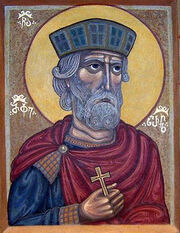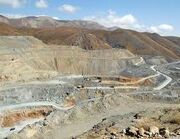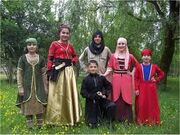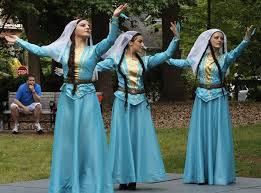Motto | |||||||
| Anthem | "Freedom be Praise" | ||||||
| Capital | Astoria | ||||||
| Largest city | Astoria | ||||||
| Language | Hobrazian | ||||||
| Religion | Hobaism Hosianism | ||||||
| Ethnic Groups main |
Hobrazian | ||||||
| others | Deltarian Zargundian | ||||||
| Demonym | Hobrazian | ||||||
| Government | Unitary parliamentary republic | ||||||
| President | Merab Tavkhelidze | ||||||
| Minister-President | Tamar Tavkhelidze | ||||||
| Legislature | National Assembly | ||||||
| Area | 1,045,200 km² | ||||||
| Population | 60,258,589 | ||||||
| GDP Total: |
2,273,834,370,015 HCR (4350) | ||||||
| per capita | 22,796 HCR (4350) | ||||||
| Currency | Hobrazian Crown (HCR) | ||||||
| Time Zone | GMT 0 | ||||||
| summer | GMT +1 | ||||||
| Drives on the | Right | ||||||
| Calling Code | +12 | ||||||
| Internet TLD | .hb | ||||||
| Organizations | World Congress, Confederate Economic Security Union | ||||||
Hobrazia (Hobrazian: ჰობრაცი, transl. Hobratsi) is a sovereign state located in southern Artania and bordered by Luthori to the north, the Hobrazian Sea to the east, Malivia to the south and Narikaton and Darnussia to the west.
Throughout the country's history, Hobrazia has typically been regarded as an insular and conservative state that was withdrawn from international affairs. At the same time it has, at times in history, been an important part of the regional and global economy due to a relatively low cost of operations for Artania and rich mineral and lumber resources.
The country's political system is a parliamentary, with a Minister-President elected by the national legislature and a President who is elected by national vote.
Etymology[]
The exact etymology of the name "Hobrazia" in Luthorian is not clear, however it is likely to be derived in some manner from the name of the Hobratz people who were among the first inhabitants of the region of modern Hobrazia.
In native Hobrazian, the name of the country is ჰობრაცი (transliterated as "Hobratsi").
History[]
The history of Hobrazia is generally divided into a number of historical eras. The "early history" of the history begins with the settlement of the region by the Deltarian people in the fifth century BCE and their interactions with the native Hobratz people. During this period there was a mixture of open conflict and peaceful relations between the indigenous population and the migrants.

Saint Vakhushti, the first Hosian Hobrazian leader
The rule of the Zarganid dynasty marks the beginning of the "ancient history" of Hobrazia at the end of the first century CE. During this period much of the modern custom and traditions of the modern Hobrazian people emerged and began to spread throughout the region. In the fifth century the Hobrazian Orthodox Church became among the first formal Hosian churches in the world.
Between the end of the eight century and the beginning of the 21st century, the Hobrazian "middle ages" represented a period of change and progression within Hobrazian society, culture and governance. At the end of this period the First Hobrazian Republic was founded and the beginning of the "modern history" of Hobrazia began. Throughout the modern period the country has fluctuated between republicanism and monarchism, as well as socialism and capitalism.
Geography[]
Among the most important geographic features in Hobrazia are the Arszan Mountains, part of the Black Mountain Chain. In the past the country has even been known as "Transarszania" or "Transarszan" in reference to its position within the mountain range. The mineral-rich nature of the mountains has provided an important source of economic development in the past.
In general terms the coastal regions of the country are forested and hilly, whereas the interior regions of Zargundia and Muzalkaz are dominated by open plains and small hills.
Government and politics[]
In recent centuries the Hobrazian political system has varied and changed frequently according to changes in the population and various other factors. Throughout this period though there have been several consistent features of Hobrazian government and politics, particularly the relatively isolated position of the country internationally and limited economic development relative to other Artanian countries.
From 4875 to 4899, Hobrazia was ruled by Fascists, with Zviad Zoidze serving as President from 4875-87 and Bernard Licheli as President from 4887-4899. In 4899 the Fascist regime was toppled in the Northern Council invasion of Hobrazia, and the Hobrazian Traditionalist Party took power. In recent years Hobrazia has attempted to boost its status on the world stage and accelerate economic development, although the nation still struggles to keep up with Artanian powers.
Government[]
Hobrazia operates with a parliamentary cabinet system of government led by the Prime Minister. The formal head of state is the President. Under the Samep'o Accords adopted in 4915, Hobrazia also retains the Vakhtanid Dynasty as a ceremonial monarchy.
Politics and elections[]
There are many defunct parties who left an impressive influence over Hobrazian politics and politicians:
- Hobrazian Traditionalist Party
- Hobratsur Komunisturi Partiis
- Hobratsuri Erovnuli P’rontis
- Hobrazian Peoples Party
- Akhali Partia
- Rep’ormis Partia
- We Say So! Party
- Capitalist Party of Hobrazia
- Clyrvská Dynastia
- Popular Front for Democratic Socialism
- Christian Socialist Party
- First Party of Hobrazia
Administrative divisions[]

Four major cities in Hobrazia with special status
Hobrazia has five sub-national administrative divisions. The sub-national administrative divisions are known as Mkhare's (Hobrazian: მხარე), usually translated as regions.
| Mkhare | Flag | Area | Population | Regional Capital |
|---|---|---|---|---|
| Deltaria | 191,700 km² | 19,954,179 | Brentaro | |
| Kiduran | 151,500 km² | 19,988,344 | Kiduran City | |
| Muzalkaz | 222,300 km² | 19,858,070 | Muzal City | |
| Stormereti | 95,700 km² | 19,957,032 | Astoria City | |
| Zargundia | 384,000 km² | 19,916,791 | Camaero |
Foreign relations[]
Although often stereotyped as inward-looking, recent Hobrazian leaders have attempted to bring Hobrazia onto the world stage. Hobrazia enjoys a particularly strong relationship with Endralon, and Endralonian companies have invested significantly in the Hobrazian economy. Some foreign policy analysts have even labeled Hobrazia a client state of Endrlaon, although government officials dispute such a classification.
Hobrazia also maintains strong relationships with its Western neighbor Narikaton and Darnussia, as well as fellow CESU member Yingdala.
Hobrazia has a tense relationship with its southern neighbor Malivia, whose claims of sovereignty over the Greater Malivian Empire (which allegedly include modern Hobrazia) have led to an almost total break in diplomatic relations. Hobrazia has also publicly positioned itself as an opponent of Deltaria, and Hobrazian leaders have repeatedly criticized Deltaria's Communism as a threat to global stability.
Economy[]
Hobrazia has a diversified economy with the largest sectors being tourism, agriculture and mining. About 52% of the Hobrazian workforce is employed in agriculture which makes up about 18% of Hobrazia's GDP. Most of these are engaged in substinence farming. Tourism is an important forex earner, with nearly 2 million foreigners visiting the country in 3702-3. Hobrazia has large deposits of commercially exploitable copper, zinc, gold, silver, coal and aluminium. Mineral production counted for 8% of GDP in 3701.

Mining in Zargundia
Hobrazia's economy is being restructured from one of a socialist model with high levels of state ownership to that of a corporatist model, with lesser public ownership but remaining with relatively high regulation. Hobrazia has a progressive income tax regime from 15% to 58%. Corporation tax is at 25% while VAT is 10% for basics and 20% for luxury goods.
Education[]
Education in Hobrazia is divided into four states. The first is the nursery stage which children attend from ages 4 to 6. The second is the primary school stage from age 6 to 11 (Grades 1 to 6). Following that is the junior high school stage attended between the age of 12 and 15 (Grades 7 to 10) At 15 students have to select continuing with a specialised academic path or a professional one. This is the fourth stage and is done over three years (15-18). All schools (except some higher education ones) in Hobrazia are private but the Government runs a voucher system to fund each student's education.
Hobrazia has several well regarded universities (a relic from the communist era) Many of them are state owned but an increasing number of private ones are being opened. The best regarded universities are the Hobrazian School of Public Affairs, the Agrarian University of Muzalkaz, the University of Northern Stormereti, the University of Zargundia, and the Hobrazian Technical Institute.
Healthcare[]
Hobrazia has a private based universal healthcare system. The government manages the national health insurance programs and pays for all citizens' healthcare which is received from private hospitals and physicians. The amount of public coverage received by a citizen depends on their annual income with low income citizens receiving 100% coverage while the highest earners get just about 25%.
Demographics[]
Population[]
Approximately 74% of Hobrazians belong to the Hobrazian ethnicity, although the country also holds significant minorities of Zargundian (13%) and Deltarian (10%) people. Notably, Hobrazia's southernmost region of Deltaria also houses a number of Malivian immigrants.
Language[]
Hobrazians speak the Hobrazian language, which is a language isolate with no known connection to any other language. Hobrazian uses its own alphabet, created during the Middle Ages. Although the letters of the Hobrazian alphabet largely follow the order of the Kalopian alphabet, the two alphabets seem to be unrelated.
Religion[]
Hobaism, a polytheistic nature religion, and the Hobrazian Orthodox Church, a Patriarchal branch of Hosianism, were once Hobrazian state religions, to which the majority of the population adheres. A small minority of Hobrazians adhere to the Aurorian Patriarchal Church, and in recent years the Luthori-based Path to Paradise's Gate new religious movement has gained followers in the north of the country.
Ethnicity[]

A Hobrazian family
The Hobrazian Republic is largely homogeneous in its ethnic makeup though liberal immigration laws have given rise to a few minority groups. Most of the population is formed of ethnic Hobrazians. The modern Hobrazian ethnic makeup was created by the merger of two tribes, the Hobratz and the Zargunians. The latter were the descendants of Deltarians, coming from modern Deltaria, and most Hobrazians therefore view Deltarians as their genetic cousins.
Public Holidays[]

A traditional Hobrazian festival
Hobrazia has many holidays and festivals throughout the year, thanks largely to the combination of Hobaist, Hobrazian Orthodox Hosian, and secular beliefs.
Secular Holidays[]
- Oktoberfest- A holiday that commerates Hobrazian beer-crafting. A perennial favorite for tourists.
- Hobrazia Day- Commemorates the founding of the first Republic.
- Labour Day
- Halloween
- Festivus
- New Year's Eve and Day
Holidays of the Hobrazian Orthodox Church[]
Numerous in the liturgical calendar, but the two most important are the Festivity of Descent and the Festivity of Birth.
Holidays in Hobaism[]
- The Festival of Fertility (March 25th – April 5th) - This is where Hobaists celebrate the coming of the new season and ask the Hob-A for a fertile crop and animals for food.
- Midsummer (20th June-30th June)- Celebration of mid-summer when the Sun is at its height and the day its longest.
- Feast for the dead (30th October-9th November)- Celebration of those who have been before (died) and inviting them to feast with the living.
- New Year (28th December-6th January)- Celebration of the New Year. A large tree cut from the sacred forest is burned throughout and the ashes then taken by each of the tribes.
| Nations of Artania |
|---|
|
|
|}








